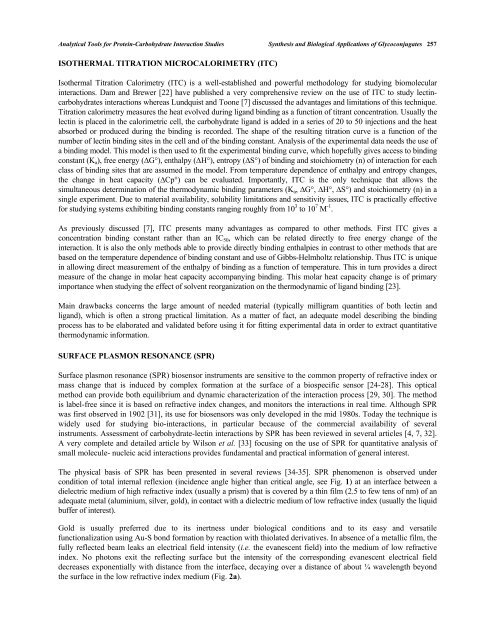chapter 2 - Bentham Science
chapter 2 - Bentham Science
chapter 2 - Bentham Science
You also want an ePaper? Increase the reach of your titles
YUMPU automatically turns print PDFs into web optimized ePapers that Google loves.
Analytical Tools for Protein-Carbohydrate Interaction Studies Synthesis and Biological Applications of Glycoconjugates 257<br />
ISOTHERMAL TITRATION MICROCALORIMETRY (ITC)<br />
Isothermal Titration Calorimetry (ITC) is a well-established and powerful methodology for studying biomolecular<br />
interactions. Dam and Brewer [22] have published a very comprehensive review on the use of ITC to study lectincarbohydrates<br />
interactions whereas Lundquist and Toone [7] discussed the advantages and limitations of this technique.<br />
Titration calorimetry measures the heat evolved during ligand binding as a function of titrant concentration. Usually the<br />
lectin is placed in the calorimetric cell, the carbohydrate ligand is added in a series of 20 to 50 injections and the heat<br />
absorbed or produced during the binding is recorded. The shape of the resulting titration curve is a function of the<br />
number of lectin binding sites in the cell and of the binding constant. Analysis of the experimental data needs the use of<br />
a binding model. This model is then used to fit the experimental binding curve, which hopefully gives access to binding<br />
constant (Ka), free energy (G°), enthalpy (H°), entropy (S°) of binding and stoichiometry (n) of interaction for each<br />
class of binding sites that are assumed in the model. From temperature dependence of enthalpy and entropy changes,<br />
the change in heat capacity (Cp°) can be evaluated. Importantly, ITC is the only technique that allows the<br />
simultaneous determination of the thermodynamic binding parameters (Ka, G°, H°, S°) and stoichiometry (n) in a<br />
single experiment. Due to material availability, solubility limitations and sensitivity issues, ITC is practically effective<br />
for studying systems exhibiting binding constants ranging roughly from 10 3 to 10 7 M -1 .<br />
As previously discussed [7], ITC presents many advantages as compared to other methods. First ITC gives a<br />
concentration binding constant rather than an IC50, which can be related directly to free energy change of the<br />
interaction. It is also the only methods able to provide directly binding enthalpies in contrast to other methods that are<br />
based on the temperature dependence of binding constant and use of Gibbs-Helmholtz relationship. Thus ITC is unique<br />
in allowing direct measurement of the enthalpy of binding as a function of temperature. This in turn provides a direct<br />
measure of the change in molar heat capacity accompanying binding. This molar heat capacity change is of primary<br />
importance when studying the effect of solvent reorganization on the thermodynamic of ligand binding [23].<br />
Main drawbacks concerns the large amount of needed material (typically milligram quantities of both lectin and<br />
ligand), which is often a strong practical limitation. As a matter of fact, an adequate model describing the binding<br />
process has to be elaborated and validated before using it for fitting experimental data in order to extract quantitative<br />
thermodynamic information.<br />
SURFACE PLASMON RESONANCE (SPR)<br />
Surface plasmon resonance (SPR) biosensor instruments are sensitive to the common property of refractive index or<br />
mass change that is induced by complex formation at the surface of a biospecific sensor [24-28]. This optical<br />
method can provide both equilibrium and dynamic characterization of the interaction process [29, 30]. The method<br />
is label-free since it is based on refractive index changes, and monitors the interactions in real time. Although SPR<br />
was first observed in 1902 [31], its use for biosensors was only developed in the mid 1980s. Today the technique is<br />
widely used for studying bio-interactions, in particular because of the commercial availability of several<br />
instruments. Assessment of carbohydrate-lectin interactions by SPR has been reviewed in several articles [4, 7, 32].<br />
A very complete and detailed article by Wilson et al. [33] focusing on the use of SPR for quantitative analysis of<br />
small molecule- nucleic acid interactions provides fundamental and practical information of general interest.<br />
The physical basis of SPR has been presented in several reviews [34-35]. SPR phenomenon is observed under<br />
condition of total internal reflexion (incidence angle higher than critical angle, see Fig. 1) at an interface between a<br />
dielectric medium of high refractive index (usually a prism) that is covered by a thin film (2.5 to few tens of nm) of an<br />
adequate metal (aluminium, silver, gold), in contact with a dielectric medium of low refractive index (usually the liquid<br />
buffer of interest).<br />
Gold is usually preferred due to its inertness under biological conditions and to its easy and versatile<br />
functionalization using Au-S bond formation by reaction with thiolated derivatives. In absence of a metallic film, the<br />
fully reflected beam leaks an electrical field intensity (i.e. the evanescent field) into the medium of low refractive<br />
index. No photons exit the reflecting surface but the intensity of the corresponding evanescent electrical field<br />
decreases exponentially with distance from the interface, decaying over a distance of about ¼ wavelength beyond<br />
the surface in the low refractive index medium (Fig. 2a).

















